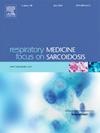Exploring the complexities of intestinal and pulmonary microbiota in cystic fibrosis: A multi-omics approach
IF 3.1
3区 医学
Q2 CARDIAC & CARDIOVASCULAR SYSTEMS
引用次数: 0
Abstract
Background
We aimed to elucidate the cystic fibrosis (CF) microbiota composition (shotgun metagenomics) and functionality (short-chain fatty acids, SCFAs).
Methods
Fecal and sputum samples were recruited from 39 clinically stable CF subjects.
Results
Bacillota and Pseudomonadota were dominant in both gut and lung compartments, whereas Ascomycota were the most abundant fungi in feces, and Basidiomycota, especially Malassezia globosa, in sputum. Viruses accounted for 0.4 % of the relative abundance in the gut and 0.6 % in lungs. Mycobacteroides abscessus was genetically identified in 10 individuals, although only 2 had positive cultures. Patients with higher levels of Pseudomonas filamentous phages had negative cultures for P. aeruginosa. The protozoan Toxoplasma gondii was detected in all sputum samples, accounting for 0.25 % of the metagenomic reads, with further PCR-confirmation in 50 % of subjects, including children. No correlation was found between SCFA and lung function or microbial composition. The resistome of the fecal compartment was higher than that of the lungs, and a greater abundance of SCFAs in the intestine was associated with poorer lung function.
Conclusions
Patients with normal-mild lung function had higher alpha diversity in the respiratory microbiota; however, beta diversity in the stool was statistically different compared with the group with poorer lung function. Although there were no differences in SCFA concentrations, butyrate-producing bacteria were more abundant in the sputum of the group with better lung function. In fecal samples, resistome to tetracyclines, glycopeptides, and aminoglycosides predominated, whereas in sputum an enrichment of ARGs related to tetracyclines, beta-lactams, and macrolides was observed.
探索囊性纤维化中肠道和肺部微生物群的复杂性:多组学方法
我们旨在阐明囊性纤维化(CF)微生物群组成(霰弹枪宏基因组学)和功能(短链脂肪酸,SCFAs)。方法收集39例临床稳定CF患者的粪便和痰液样本。结果杆菌门和假单胞菌门真菌在肠道和肺区均占优势,粪便中以子囊菌门真菌数量最多,痰中以担子菌门真菌数量最多,尤其是全球马拉色菌。病毒在肠道中占相对丰度的0.4%,在肺部占0.6%。在10个个体中发现了脓肿分枝杆菌,尽管只有2个培养呈阳性。假单胞菌丝状噬菌体水平较高的患者铜绿假单胞菌培养阴性。在所有痰样本中检测到弓形虫原生动物,占宏基因组读数的0.25%,在50%的受试者(包括儿童)中进一步进行pcr确认。SCFA与肺功能或微生物组成没有相关性。粪室的抵抗组高于肺,肠道中scfa的丰度越大,肺功能越差。结论肺功能正常-轻度患者呼吸菌群α多样性较高;然而,与肺功能较差的组相比,粪便中的β多样性有统计学差异。虽然SCFA浓度没有差异,但肺功能较好的组痰液中产丁酸菌较多。在粪便样本中,对四环素类、糖肽类和氨基糖苷类的抵抗组占主导地位,而在痰中,观察到与四环素类、β -内酰胺类和大环内酯类相关的ARGs富集。
本文章由计算机程序翻译,如有差异,请以英文原文为准。
求助全文
约1分钟内获得全文
求助全文
来源期刊

Respiratory medicine
医学-呼吸系统
CiteScore
7.50
自引率
0.00%
发文量
199
审稿时长
38 days
期刊介绍:
Respiratory Medicine is an internationally-renowned journal devoted to the rapid publication of clinically-relevant respiratory medicine research. It combines cutting-edge original research with state-of-the-art reviews dealing with all aspects of respiratory diseases and therapeutic interventions. Topics include adult and paediatric medicine, epidemiology, immunology and cell biology, physiology, occupational disorders, and the role of allergens and pollutants.
Respiratory Medicine is increasingly the journal of choice for publication of phased trial work, commenting on effectiveness, dosage and methods of action.
 求助内容:
求助内容: 应助结果提醒方式:
应助结果提醒方式:


